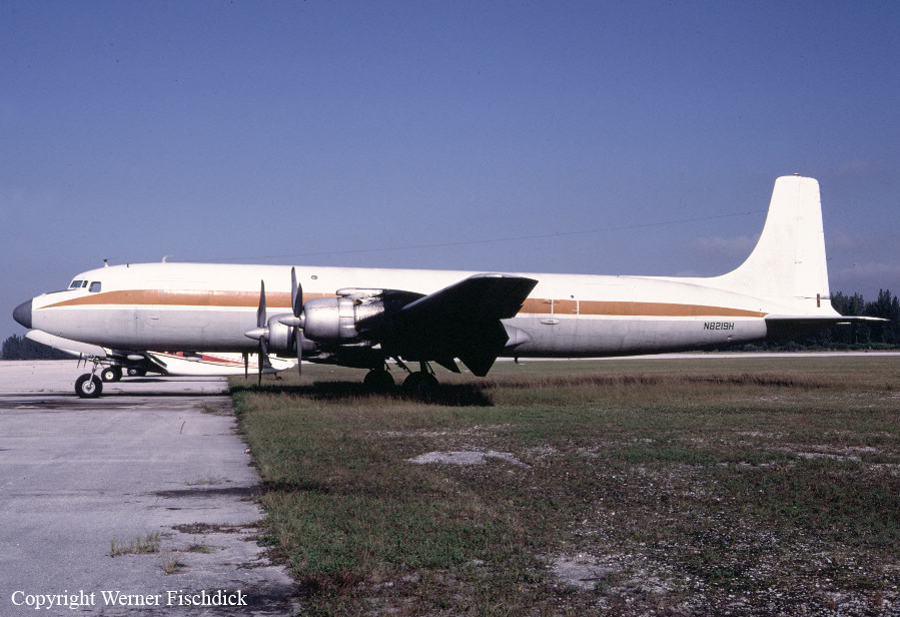Country
Crash of a Douglas DC-7CF in Santo Domingo
Date & Time:
Feb 18, 1993
Registration:
HI-599CT
Survivors:
Yes
MSN:
45208
YOM:
1957
Crew on board:
3
Crew fatalities:
Pax on board:
0
Pax fatalities:
Other fatalities:
Total fatalities:
0
Circumstances:
During the takeoff roll at Santo Domingo-Las Américas Airport, the copilot started the rotation but the aircraft failed to respond. The captain took over controls when the aircraft started to veer to the left and skidded. The crew aborted the takeoff procedure when the aircraft rolled left and right, causing the right wing to struck the ground. On impact, both right engines n°3 and 4 were torn off. Out of control, the aircraft veered off runway to the right, lost its undercarriage and came to rest, bursting into flames. All three crew members escaped uninjured while the aircraft was destroyed.
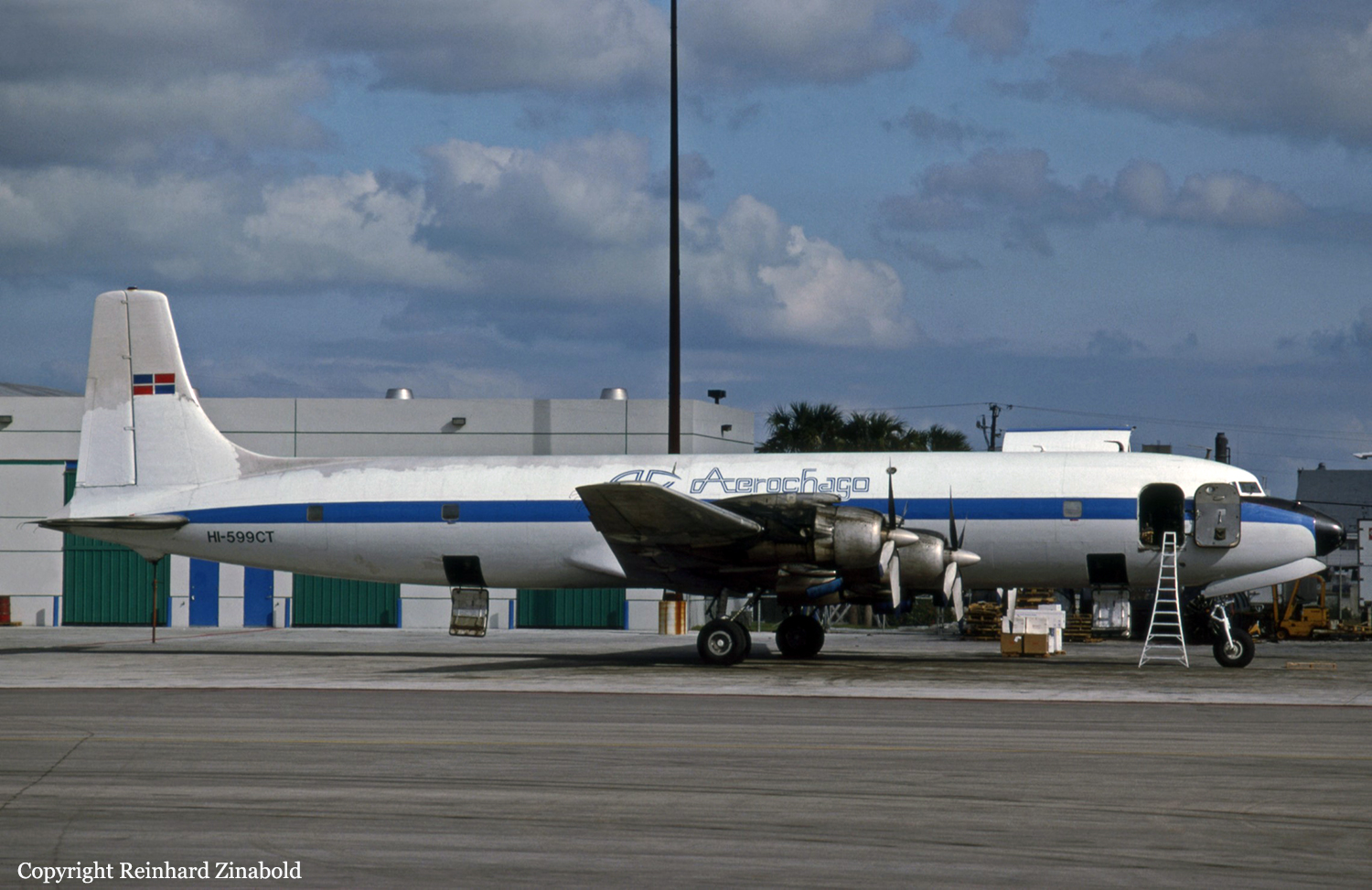
Crash of a Douglas DC-7CF off Fort Lauderdale
Date & Time:
Nov 6, 1992 at 0225 LT
Registration:
HI-619SP
Survivors:
Yes
Schedule:
Fort Lauderdale - Santo Domingo
MSN:
45158
YOM:
1956
Crew on board:
3
Crew fatalities:
Pax on board:
2
Pax fatalities:
Other fatalities:
Total fatalities:
0
Circumstances:
The crew reported over radio that the #4 engine failed shortly after takeoff, and they were attempting to dump fuel when the #2 engine overheated. They then intentionally ditched the airplane. The wreckage was recovered about 2 weeks afterward, and the airplane was about 50% corroded away. Due to massive salt water corrosion, no preimpact failure/malfunction of the #4 engine could be identified. No record of airplane/operator being granted cfr part 129 certificate authority. No substantiation of the times in service for the airplane, engines, propellers, and time change components or airworthiness directives could be determined.
Probable cause:
Failure of the #4 engine for an undetermined reasons(s), and the inability of the airplane to remain airborne due to the over gross weight takeoff performed by the pilot. Factors which contributed to the accident were: the questionable airworthiness of the airplane and engines due to the lack of records, and the failure of the federal aviation administration to adequately surveil the operator.
Final Report:
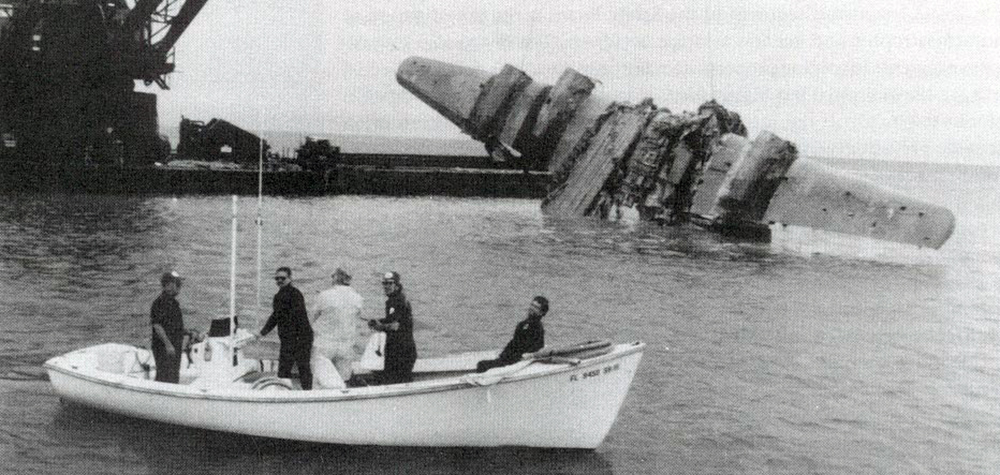
Crash of a Douglas DC-7B near Kyburz: 2 killed
Date & Time:
Oct 1, 1992 at 1225 LT
Registration:
N848D
Survivors:
No
Schedule:
Stockton - Stockton
MSN:
45454
YOM:
1958
Flight number:
Tanker 61
Crew on board:
2
Crew fatalities:
Pax on board:
0
Pax fatalities:
Other fatalities:
Total fatalities:
2
Circumstances:
Douglas DC-7B airtanker N848D had been operating from Stockton, CA (SCK) and had made several drops of retardant on the southeast edge of a fire on the El Dorado National Forest. Their first mission on October 1, 1992, had begun at 08:33. Their fourth mission had them departing the base at 11:56. Their departure was immediately followed by a Lockheed SP2H enroute to the same fire. The DC-7B arrived in the fire vicinity at an elevation of about 6,500 feet MSL at 12:20. Air attack briefed the DC-7B’s two-person flight crew for their retardant drop. Air attack was flying at approximately 7,500 feet MSL. The planned drop was to be made from north to south about one mile west of the upper dam on the reservoir. It was to be the air tanker’s first drop in this particular location. The visibility was good, in excess of ten miles, and turbulence was reported as mild, but bumpy. The area over the lake to the east of the drop pattern was experiencing reduced visibility due to smoke. According to occupants of the second airtanker, the DC-7B made a turn around the fire and was descending northbound for a drop out of a right hand pattern when the DC-7B captain indicated that he wanted to depart the pattern as he had a problem with an engine. He suggested the second airtanker perform the intended drop while he worked with his engine problem. The second airtanker then received attention from air attack and began a circle to fly a pattern similar to the pattern the DC-7B had flown. Shortly thereafter, air attack asked the DC-7B if he needed to abort (drop) his load of retardant. That captain replied that he might have to if he couldn’t solve his engine problem. All communications were normal. Air attack was operating without lead plane assistance as the lead plane had departed the scene for fuel a few minutes before, instructing air attack to perform drops on the west side of the reservoir. Another lead plane was about six minutes out. The mishap air tanker was reported to be descending at about 6,000 feet MSL heading in a north-northwesterly direction after departing the drop pattern, with no visible signs of engine problems and no indication of concern present in his radio transmissions. The DC-7B continued northbound toward gently rising terrain about two miles from the intended drop site and was next observed heading in an easterly direction and low to the ground. The airtanker was reported to be in a sharply pitched up attitude prior to dropping its retardant. Air attack reported that he observed the retardant start and stop, but did not know if a full load had been dropped. He said the load was continuous. The DC-7B was then reported to fall off on the right wing as it descended steeply toward the ground. During this sequence, the captain transmitted on the radio, "We’re going in, we’re going in." It was at this point that tree strikes occurred which removed the horizontal stabilizers and elevators from the tail of the airtanker. This entire sequence took place within the span of about 60 seconds. The airtanker then went behind a ridge and white smoke was observed rising from the site. The airtanker had impacted the ground in steep terrain at an elevation of approximately 5,100 feet MSL. Some of the wreckage was deposited in a creek bottom and the remainder was located on an adjacent south-facing slope. Both the captain and copilot were fatally injured. The aircraft was totally destroyed.
Probable cause:
The accident was the probably the consequence of the pilot’s preoccupation, inattention, or possible distraction while operating the airtanker in close proximity to terrain. The following contributing factors were reported:
- Crew Management,
- The pilots failed to recognize the severity of the situation and were reluctant to abort their retardant load.
- Crew Management,
- The pilots failed to recognize the severity of the situation and were reluctant to abort their retardant load.
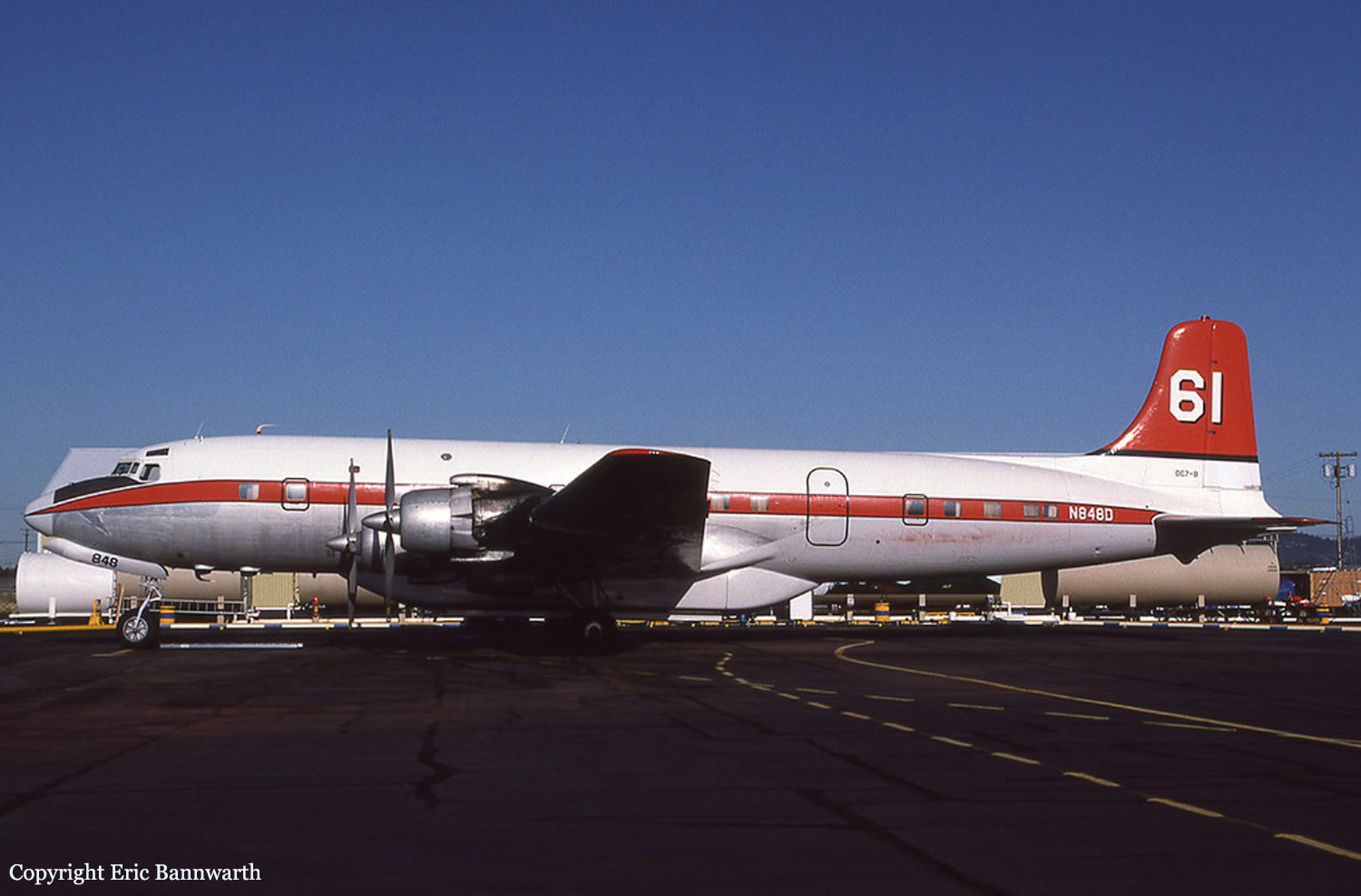
Crash of a Douglas DC-7CF near Bir Moghreïn: 5 killed
Date & Time:
Dec 8, 1988
Registration:
N284
Survivors:
No
Schedule:
Dakar - Agadir
MSN:
45203
YOM:
1957
Crew on board:
5
Crew fatalities:
Pax on board:
0
Pax fatalities:
Other fatalities:
Total fatalities:
5
Circumstances:
En route from Dakar to Agadir, while cruising at the altitude of 11,000 feet, the aircraft was hit by a SAM-7 surface-to-air missile. An engine detached and out of control, the aircraft entered a dive and crashed in a desert area near Bir Moghreïn. All five occupants were killed. They were on their way to Agadir on behalf of the United States Agency for International Development.
Probable cause:
Shot down by a SAM-7 surface-to-air missile fired by soldiers of the Front Polisario.
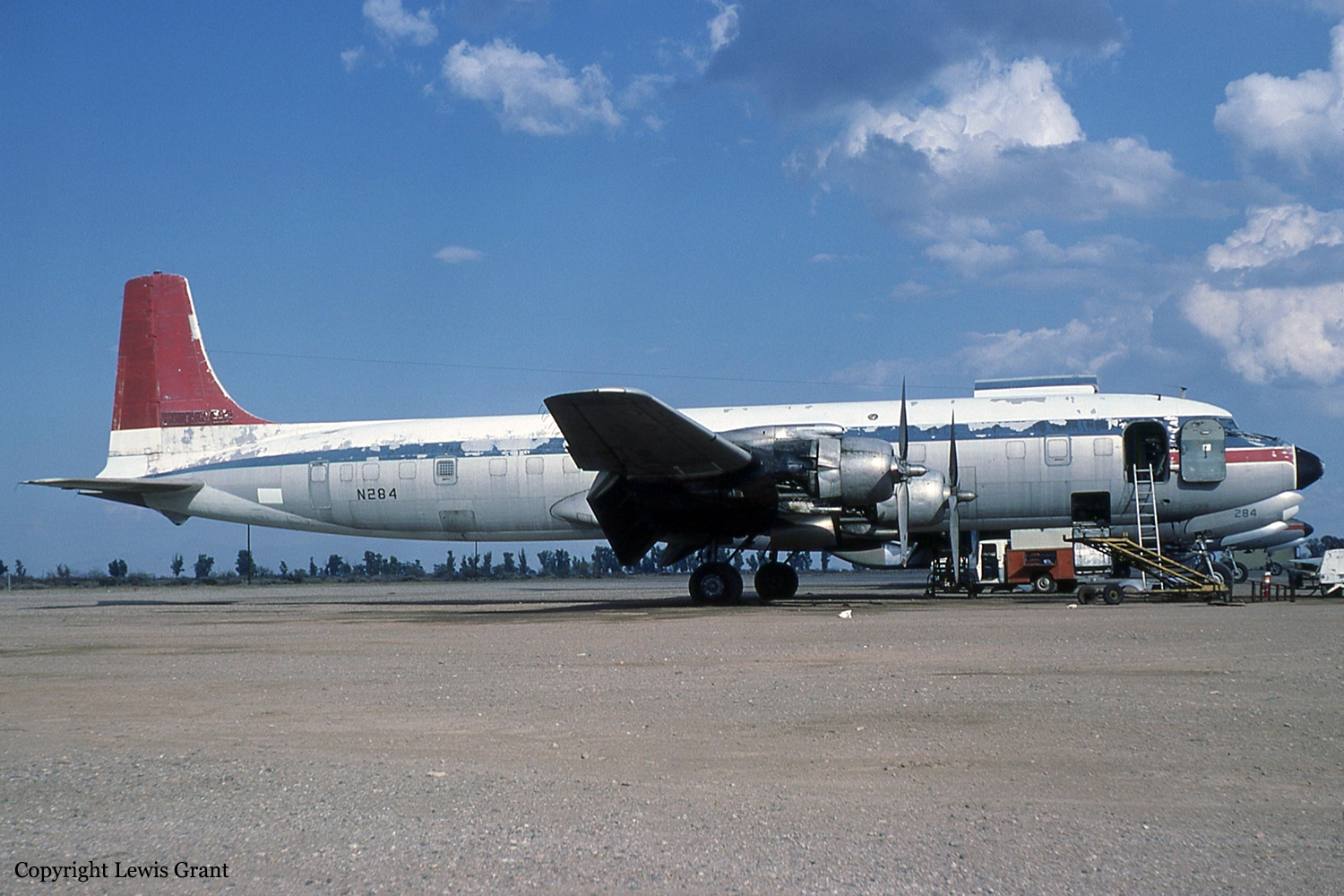
Crash of a Douglas DC-7C in Dakar: 3 killed
Date & Time:
Oct 9, 1986
Registration:
N5903
Survivors:
Yes
Schedule:
Dakar - Dakar
MSN:
45071
YOM:
1956
Crew on board:
3
Crew fatalities:
Pax on board:
1
Pax fatalities:
Other fatalities:
Total fatalities:
3
Circumstances:
The four engine aircraft was engaged in a locust spraying mission in Senegal on behalf of the U.S. Agency for International Development. It was carrying one passenger, three crew members and a load of pesticides. Shortly after takeoff from Dakar-Yoff Airport, while in initial climb, white smoke was coming from the engine n°3 while the engine n°4 fire alarm sounded. The engine n°4 was shut down and its propeller was feathered when the aircraft lost height and crashed, bursting into flames. The passenger was seriously injured while all three crew members were killed.
Probable cause:
Engine problems for unknown reasons.
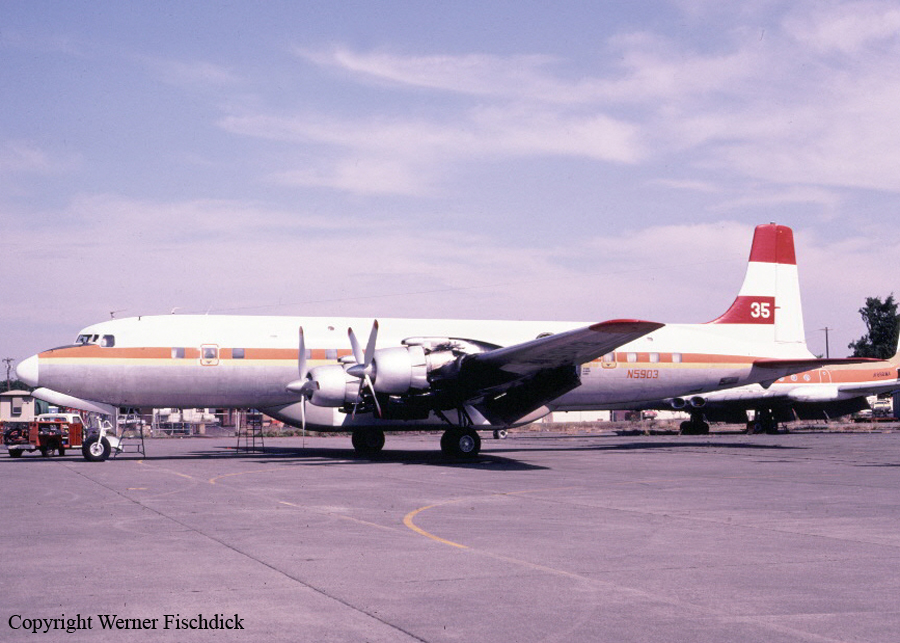
Crash of a Douglas DC-7CF in Colombia
Date & Time:
Dec 31, 1980
Registration:
N8219H
MSN:
45214/897
YOM:
1957
Crew on board:
0
Crew fatalities:
Pax on board:
0
Pax fatalities:
Other fatalities:
Total fatalities:
0
Circumstances:
Crashed somewhere in Colombia while on a drug smuggling flight after being shot down by the Colombian Army. The exact date remains unknown (somewhere in 1980) as well as the crew's fate.
Probable cause:
Shot down by the Colombian Army.
